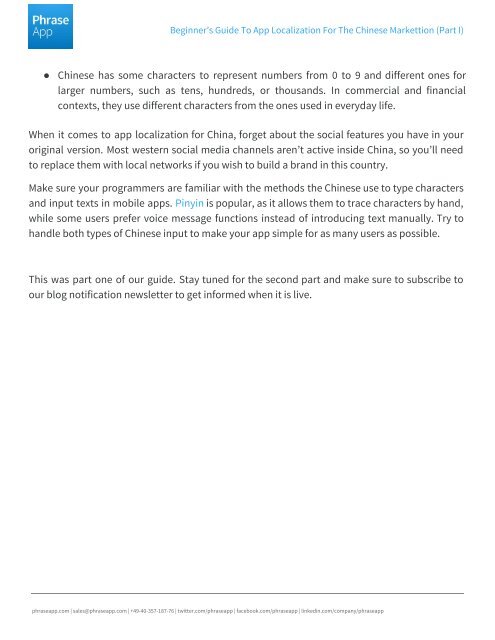Beginner’s Guide To App Localization For The Chinese Market (Part 1)
You also want an ePaper? Increase the reach of your titles
YUMPU automatically turns print PDFs into web optimized ePapers that Google loves.
<strong>Beginner’s</strong> <strong>Guide</strong> <strong>To</strong> <strong>App</strong> <strong>Localization</strong> <strong>For</strong> <strong>The</strong> <strong>Chinese</strong> <strong>Market</strong>tion (<strong>Part</strong> I)<br />
● <strong>Chinese</strong> has some characters to represent numbers from 0 to 9 and different ones for<br />
larger numbers, such as tens, hundreds, or thousands. In commercial and financial<br />
contexts, they use different characters from the ones used in everyday life.<br />
When it comes to app localization for China, forget about the social features you have in your<br />
original version. Most western social media channels aren’t active inside China, so you’ll need<br />
to replace them with local networks if you wish to build a brand in this country.<br />
Make sure your programmers are familiar with the methods the <strong>Chinese</strong> use to type characters<br />
and input texts in mobile apps. Pinyin is popular, as it allows them to trace characters by hand,<br />
while some users prefer voice message functions instead of introducing text manually. Try to<br />
handle both types of <strong>Chinese</strong> input to make your app simple for as many users as possible.<br />
This was part one of our guide. Stay tuned for the second part and make sure to subscribe to<br />
our blog notification newsletter to get informed when it is live.<br />
phraseapp.com | sales@phraseapp.com | +49-40-357-187-76 | twitter.com/phraseapp | facebook.com/phraseapp | linkedin.com/company/phraseapp

















